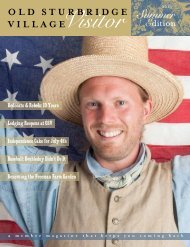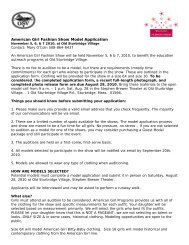2008-2009 Building Momentum - Old Sturbridge Village
2008-2009 Building Momentum - Old Sturbridge Village
2008-2009 Building Momentum - Old Sturbridge Village
You also want an ePaper? Increase the reach of your titles
YUMPU automatically turns print PDFs into web optimized ePapers that Google loves.
O L D S T U R B R I D G E<br />
V I L L A G E Visitor<br />
I N D E P E N D E N C E<br />
“The Day…opened with the discharge of Cannon &<br />
the ringing of the Bell.…The cannon roared till Sundown,<br />
& the Evening was illumined with Rockets,<br />
& the Band gave great pleasure to the company.”<br />
Diary of WILLIAM BENTLEY, pastor of the East Church in Salem, Massachusetts, July 4, 1804.<br />
Photo linda Peterson ~ OSV SummER <strong>2009</strong><br />
Fireworks!<br />
by Tom Kelleher,<br />
Curator of Historic Trades<br />
Everybody loves a parade!<br />
A short history of an American tradition<br />
F<br />
ireworks have been a part of public celebrations since long before the Fourth of July<br />
was anything more than another day in summer. About a thousand years ago, the<br />
Chinese invented gunpowder, and with it fireworks. By the 1200s the wonders of<br />
fireworks (and the horrors of gunpowder) traveled to Italy, which led the West in<br />
fireworks innovation for centuries. Kings and nobles commissioned fireworks for<br />
coronations, birthdays, weddings, and all sorts of celebrations.<br />
In America, fireworks predate independence, although public displays were urban phenomena. When the<br />
hated Stamp Act was repealed in 1766, in Boston a “liberty tree was decked with lanterns; bells and flags and<br />
music, illuminations and fireworks, proclaimed…the gratitude of the people…[John] Hancock illuminated his<br />
house and discharged fireworks in front of it from a stage….”<br />
After America’s independence was ratified, John Adams wrote to his wife Abigail that the day, “ought to be<br />
solemnized with Pomp and Parade, with Shows, Games, Sports, Guns, Bells, Bonfires and Illuminations from<br />
one End of this Continent to the other from this Time forward forever more.”<br />
On July 4, 1777, the city of Philadelphia hosted a celebration that included fireworks. In country towns on<br />
Independence Day, “the mechanics generally laid aside their labor,” and “citizens” spent the day “generally in<br />
great hilarity. Flags were displayed by all who could command them.” But without urban wealth, concentrated<br />
populations, or large expanses of open water over which to safely discharge fireworks, rural residents made do<br />
with church bells, cannons, and muskets.<br />
Boston has long hosted Independence Day fireworks. In 1805, Reverend William Bentley of Salem,<br />
Massachusetts, “walked to the Hill…& there we saw part of the display of fireworks in Boston.”<br />
However, the skyrockets over Boston that Rev. Bentley saw were not as spectacular as modern shows.<br />
He may have seen starbursts, serpents, and bright lights on tiny parachutes. Iron and zinc filings added to the<br />
gunpowder made modest sparks, but early fireworks lacked the brightness and spectrum of vibrant colors we<br />
expect today. Early 19th-century pyrotechnicians experimented with a wide variety of additives to make<br />
fireworks appear in various colors, but the hues were faint at best and a complete waste in aerial displays.<br />
Chemistry made great strides in the 19th century. By the 1830s, Italian pyrotechnicians began adding artificial<br />
metallic compounds to fireworks, producing brighter, more vibrant colors. Sodium nitrate made a dazzling yellow;<br />
strontium chloride a vibrant red; barium chloride a true green; and copper chloride a deep blue. Gunpowder<br />
made with potassium chlorate burned faster and hotter, making the new colors even deeper and brighter.<br />
By the late 19th century, electricity allowed scientists to isolate magnesium and aluminum. When ignited,<br />
these produce intense white light, making fireworks burn brighter and whiter.<br />
Today even more efficient oxidizers, electronic ignition systems, synchronized music broadcasts, and boundless<br />
human creativity continue to advance the pyrotechnician’s art.<br />
July 4, <strong>2008</strong>, marked the start of a new tradition at <strong>Old</strong> <strong>Sturbridge</strong> <strong>Village</strong><br />
Fireworks on the Fourth. For the first time, OSV added nighttime festivities to its already popular Independence<br />
Day Celebration.<br />
The sold-out crowd of 4,000 streamed into the <strong>Village</strong> behind a procession of costumed interpreters for three<br />
hours of music, magic, and family entertainment before heading to the countryside at dusk for the fireworks<br />
display. Some guests brought their own picnics, and others enjoyed the selection of beer, wine, food, and soft drinks<br />
offered for sale by the <strong>Village</strong>. Kids enjoyed old-fashioned sack races, pie-eating contests, 1830s-style Base Ball, and<br />
water balloon tosses, and the Common was packed with crowds enjoying “Lucky Bob the Comedic Juggler” and<br />
the Heritage String Band.<br />
Around 9:00 p.m. the crowd moved to the Freeman Farm to take up positions for fireworks viewing. The fields<br />
were full of people sitting on blankets or in lawn chairs enjoying the balmy summer evening. As dusk deepened<br />
and the very first fireworks shell burst into the sky, there was an audible gasp, and then nearly 4,000 people in<br />
unison said,<br />
OSV SummER <strong>2009</strong> sixteen




